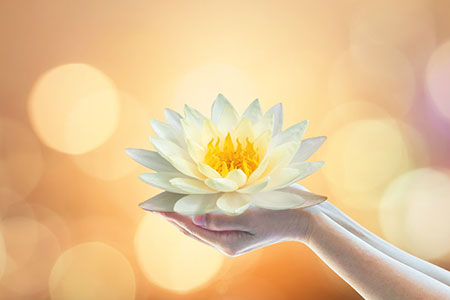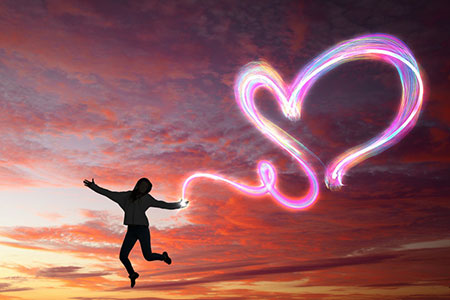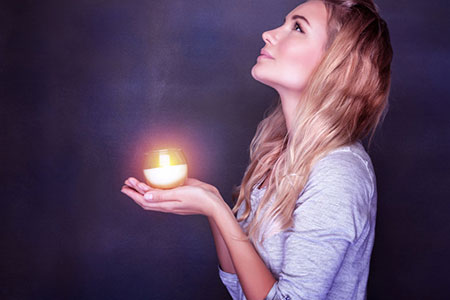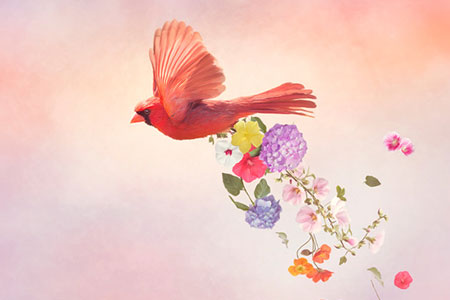religion
It’s Always Darkest Before The Dawn
 Concepts of the Divine, with an ever-changing definition, have been part of the human experience since the beginning of time. Most of the world’s people throughout history continue to recognize a place for divinity in life.
Concepts of the Divine, with an ever-changing definition, have been part of the human experience since the beginning of time. Most of the world’s people throughout history continue to recognize a place for divinity in life.
Our spiritual journey, throughout the ages, has been steeped in mystery and often, superstition and dogma. Organized religions have historically attempted to answer deep questions, and have sometimes provided comfort and solace to people during times of upheaval.
However, the most important questions have been left unanswered. For example, we know precious little about ancient, prehistoric cultures that worshiped the Sacred Feminine. Earliest recorded myths and legends have been lost or destroyed, and most stories that remain portray not only a divine battle of the sexes, but a difficult, contentious relationship between the divine and human beings.
The Greek gods, for example, were capricious and mean-spirited. They plotted all sorts of obstacles that humans either did, or did not overcome in order to survive. Guile and trickery also set the stage for many myths from various indigenous cultures, in early human-god myth making.
With the rise of monotheistic religions, mankind was taught to blindly accept whatever lot the almighty doled out, fairly or unfairly. Emphasis was placed on omnipotent power, absolute authority and greatness, beyond any human capacity to comprehend, much less participate in.
These attitudes toward humans’ relationship with God have been echoed in authoritarian family and community practices, and even the military forces of nations. God became the ‘Almighty Father in the Sky’ issuing strict orders. There was no room for questioning in an authoritarian family or society. “Because I said so,” was reason enough to blindly obey. Punishment for infractions or disobedience was swift and sure.
Can A Christian Be Psychic?
 I am often asked if I personally have a problem being a professional psychic, as well as a Christian. Some people seem to feel that working as a psychic is against the teachings of the Bible.
I am often asked if I personally have a problem being a professional psychic, as well as a Christian. Some people seem to feel that working as a psychic is against the teachings of the Bible.
Growing up in a Christian, church-going family I was never taught that being a psychic was something considered as being wrong in the Bible.
Not only were we brought up in the Christian faith, but I also come from a long line of psychics in my family. Being both psychic and Christian is something that was never considered strange in my family; to us it was normal.
The Bible has accounts of many great prophets that did amazing things. Not only did some of them contribute to the actual writing of the Bible, but they were also a part of many miracles and wonders. They made a difference in the outcome of important Biblical events. They were the messengers of God.
The calling of a psychic is very similar to the work of a prophet. I guess it is just on a smaller scale? When a psychic does a reading they see many things from the past, the present and the future, the same way the prophets did in the Bible. The prophets were there to help, guide, advise and warn of coming danger, the same way modern psychics read for their clients.
Being born a psychic or medium is a God-given talent and calling. Did you know that one of the world’s most well-known psychics, Edgar Cayce, was also a devout Christian who read through the whole Bible once every year. Why should a psychic, who received his gifts from God, be persecuted as someone who is doing evil?
Life Invites You To Dance
 In the quietude of the morning, as the sun gently rises with a golden glow glistening through the trees, I feel a calm within reflecting the clear blue sky. The season is changing. The heavy heat and humidity of summer has dissolved into an idyllic balance of coolness, warmth, and lightness in the air.
In the quietude of the morning, as the sun gently rises with a golden glow glistening through the trees, I feel a calm within reflecting the clear blue sky. The season is changing. The heavy heat and humidity of summer has dissolved into an idyllic balance of coolness, warmth, and lightness in the air.
It is a time of transition, moving toward autumn, but not fully there yet. For me, it is a season of revitalization and renewed inspiration. The vastness of nature expands all around and the interconnectedness of every soul within it reaches the forefront of my awareness.
Today, I will be intuitively teaching a dancing with nature class at the World Peace Sanctuary nearby. All of life is a dance with nature and its Creator. We are invited into that partnership and party of life, to move together in joy and harmony.
But how do we join the flow? It begins at the feet, at the root of the tree of life. In Srimad-Bhagavatam, the great celestial sage Narada instructs, “As pouring water on the root of a tree energizes the trunk, branches, twigs and everything else, and as supplying food to the stomach enlivens the senses and limbs of the body, simply worshiping the Supreme Personality of Godhead through devotional service automatically satisfies the demigods, who are parts of that Supreme Personality.”
Not only are angels, nature spirits, and demigods part of the tree, but so are we. Like leaves upon it, we are connected not only with the twigs, branches, and trunk, but with the root, the very source and sustenance of all life. By watering that root with our whole-hearted attention and intention, we are nourished, supplied, and satisfied.
But what does this mean practically? It means peace and growth rest not in pursuit of individual desires, but in harmony with and service to Divine desires. Endeavoring to serve separate interests is futile and unfulfilling, just as watering the leaves and limbs of a tree individually would be. They would dry up and die if simply watered separately. Continue reading
The Lotus Flower Reading
 I recently attended an online psychic development workshop. In one of the tasks, we had to partner with another student and do a ‘flower reading.’ I know touching an object using psychometry works well in readings, but this is something else.
I recently attended an online psychic development workshop. In one of the tasks, we had to partner with another student and do a ‘flower reading.’ I know touching an object using psychometry works well in readings, but this is something else.
Our teacher paired us up and we didn’t know in advance with whom. We also had to intuitively pick a flower for our partner beforehand. At the beginning of the session, we had to show the other person the actual flower or a color photo of the flower we had chosen for them on our shared screens.
In preparation for this, I placed many pieces of paper, each with the name of a different flower on it, into a bag, shook it up, and drew one. Spirit guided me to select the Indian lotus flower or nelumbo nucifera.
When it was my turn to read for my classmate, I relaxed and observed the image of the lovely white lotus in front of me. The depth of information that came forth in the reading about her past, how her life was now, and what lay ahead, was truly amazing!
The reading revealed that she was going to be blossoming soon like the lotus, because she currently finds herself in a strong development stage. I later learned that she’d been through some dark times, almost giving up on herself. She had recently begun doing deep shadow work, as well as exploring her psychic development.
She is also recovering from a recent trauma and the lotus is traditionally known for being the ideal gift for someone recovering from any traumatic experience or physical injury. Many years ago, I attended a Yoga class during which the challenges of the lotus position was discussed in-depth. The teacher said that through proper breathwork and becoming more flexible, one’s body will allow you to achieve this pose.
I was only 19 years old at the time and not very supple. I saw no hope of achieving that position for quite some time. However, only a few classes later, we did a session during which a lot of emphasis was placed on our breathing. And to my amazement, I was able to easily get into the lotus position!
Love, Joy And The Pursuit Of Happiness
 According to the United States Declaration of Independence “life, liberty and the pursuit of happiness” are the inalienable birthrights of every human being given to us by our Creator, God, Source, the Divine.
According to the United States Declaration of Independence “life, liberty and the pursuit of happiness” are the inalienable birthrights of every human being given to us by our Creator, God, Source, the Divine.
Sadly, I find very few people to be successful in their pursuit of happiness. The same is true for finding love and joy. It seems many are merely stumbling through life trying to find it.
A teacher once told me life is like school. For some of us it’s like kindergarten – easy, uncomplicated, and lots of fun. For others it’s like graduate school with lots of difficulties and challenges to overcome.
Searching for joy, love and happiness does seem to be a ‘wild goose chase’ for many people. It truly is like chasing wild animals. The faster we run after it, the more it seems to flee. I don’t believe joy, love and happiness can be found. Well, at least not in the ways that many of us are hoping to find it.
Like happiness, the right to love is also the natural inheritance of every person. The well-known channeled text, A Course in Miracles, delves into the idea of love from a spiritual perspective. It states that it is impossible to teach love. Instead, the goal should be to remove the blockages or obstacles we have to allowing love’s presence in our lives.
I have seen repeated evidence of this in doing readings for many years now. Certain reading themes are repetitive and common themes are ‘finding love,’ or the ‘lack of love,’ or ‘loss of love.’ In all these readings one thing always becomes very clear: love itself is not an ‘out there’ thing. It is also not something that can be received from another person or thing.
In readings, Spirit will often say, “Love is not a feeling.” This one initially took me a while to understand myself, until I realized that love is in fact an intrinsic quality of being. It is already within each of us. We refer to it as the Higher Self, the Soul, or the Spirit. No one is ever separated from this innate love because it is an intrinsic aspect of our very being.
The Power Of Prayer
 I recently took part in a mediation and prayer group for the benefit of a country facing extreme turmoil. People from all over the world joined the event online via Zoom. It was a truly memorable experience that reminded me once again of the true power of prayer.
I recently took part in a mediation and prayer group for the benefit of a country facing extreme turmoil. People from all over the world joined the event online via Zoom. It was a truly memorable experience that reminded me once again of the true power of prayer.
I have participated in prayer groups and intention-setting events for individual people and animals before, but never anything on such a global scale. The energy I felt being generated from so many participants from all over the world was truly phenomenal!
Later that evening, I was watching a YouTube clip about a lady who had been in a coma for some weeks and her family had been informed that it was unlikely to survive. She had suffered severe trauma to her internal organs in a terrible accident. A prayer link had been circulated on her behalf all over the world on social media, requesting prayers for her healing and recovery.
In the video clip, she tells the story of her out-of-body experience whilst she was in a coma. She describes the beauty of the Other Side and meeting her deceased loved ones and spirit helpers. She also mentions how she was fully aware of the energy vibration of so many prayers reaching and enveloping her from all corners of the earth. So powerful were these prayers that it brought her back to this world and set the scene for her ultimate recovery and healing.
A prayer is a plea requesting intervention and help from a higher source or greater power. Prayer is a significant aspect in most, if not all religions and spiritual traditions. Jesus said, “Therefore I tell you, whatever you ask for in prayer, believe that you have received it, and it will be yours.” In Buddhism it is believed that prayer is the way to destroy fear and banish sorrow and replace it with hope and healing. Sadly, I find many spiritually aware people do not always make use of this wonderful spiritual resource on a regular basis.
